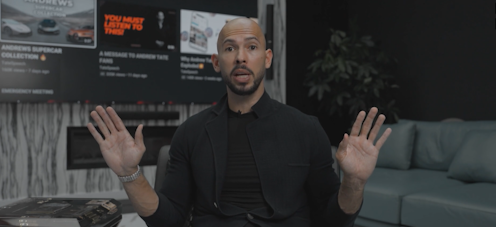
If you don’t recognize the name Andrew Tate, you have (luckily) avoided one of the most significant waves of misogyny on mainstream social media in recent memory.
Tate, a pseudo right-wing influencer who espouses deep misogyny, rocketed to fame (and infamy) thanks to clever manipulation of social media algorithms — especially TikTok. Many articles have been written about Tate’s rise to fame and subsequent banning on social media.
However, most articles fail to acknowledge that the only thing new or innovative about Tate and his rhetoric was his ability to leverage platform algorithms. Tate’s example highlights how proponents of misogyny are using new technology to amplify their messaging. And while his content is not new, his tactics present an important site of innovation and inquiry.
Andrew Tate in the history of misogyny
Andrew Tate got famous fast. In July 2022 Google searches for Tate exceeded Donald Trump and Kim Kardashian combined. Over a short period, he was transported from marginal fame to social media stardom.
Banned from Twitter in 2017 (for anti #MeToo tweets, among other things), Tate surged into mainstream consciousness on TikTok in 2022 where videos of him have been viewed more than 12 billion times.
These videos, which ranged in content from cryptocurrency tips to overt calls for violence against women, were promoted and shared heavily by the platform’s users. Arriving on the TikTok scene at the right time with the right approach worked.
Tate has said that his popularity has more to do with the appeal of his message and the desire for “real masculinity” than the outcome of algorithmic manipulation. But examining his rhetoric belies the fact that nothing Tate says is new — not the violence, not the domination, not the body politics, not the cigars, not even the shaved head to hide the changing hairline — none of it.

Tate is the newest addition to the lineup of masculinist grifters who have existed since the rise of the men’s movement. His approach works because it is modelled after previous successful masculinist grifts that have sought to attract young men with promises of power. A famous example is Daryush Valizadeh (aka Roosh V), who 20 years ago pivoted from pickup artist persona to anti-feminist and pro-rape notoriety.
This fame also resulted in organized resistance and one instance where he and his supporters were challenged to a boxing match by the Newsgirls women’s boxing club in Toronto.
Valizadeh was also not the first to leverage these anti-women and pro-sexual violence sentiments. What each of these men tap into is a desire for power over others that is socialized into young men, often subconsciously, through framing boys as protectors, leaders and budding stoics through ideas like “boys don’t cry.”
Searching for power and control
Tate and those who have come before him adopt these personas to meet a single, personal desire: power. In Tate’s case, his endeavors in the 2020s have been about accessing power through money and (potential) social media influence. Tate’s anti-woman and anti-feminist rhetoric taps into the latent violent misogyny that underpins most traditional patriarchal social structures.
This is a component of what philosophy scholar Kate Manne frames as male entitlement. The desire for power over others is one way that men find self-worth in neoliberal capitalist cultures; and for some, the easiest way is through power over women.
We see similar processes occurring in white supremacist and white nationalist spaces where violence against women and the racialized other often occur in tandem. Each version of right-wing masculinity like Tate’s is a re-hashing of the same appeals to supremacist power structures. They are tired and boring, but unfortunately no less engaging to a certain segment of the population.

Social media and deplatforming
TikTok and other social media had no interest in banning Tate until public outrage over his rhetoric became impossible to ignore. They are, after all, in the business of getting the most users to spend the most time on their platforms. Having someone like Tate get 12 billion views is good for the bottom line, even if it is bad for society.
However, deplatforming can address the actions of an individual, or at least take that person out of the spotlight. It is impossible to get all their content off the internet, but social media platforms can cut the revenue streams to individuals and have dramatic effects on how these people finance their lives and lies.
Does deplatforming eliminate misogynist or gender-violent rhetoric? No, it doesn’t. But it does pull the rug out from under some of its loudest proponents. Tate has been banned from most mainstream media, but this isn’t because his message had stopped resonating. It is because platforms faced enough pressure and outrage to do the right thing.
Luc Cousineau is the Co-Director of Research with the Canadian Institute for Far-Right Studies (CIFRS) and he receives funding for his postdoctoral research from the Université du Québec à Montréal À nous la recherche programme.
This article was originally published on The Conversation. Read the original article.








